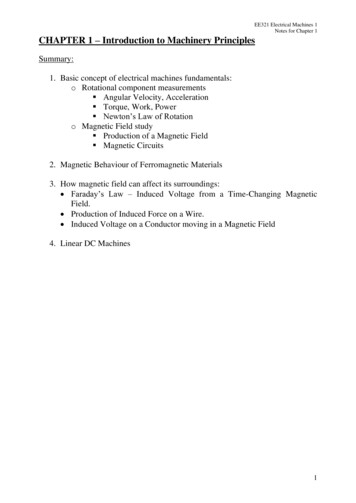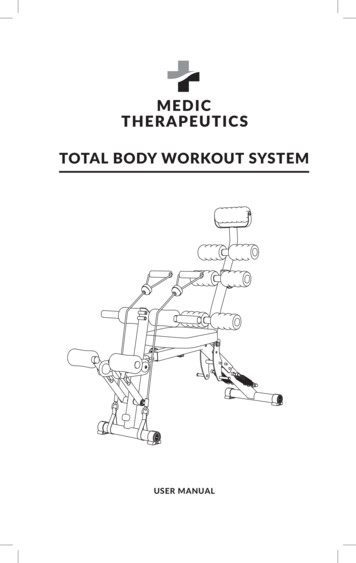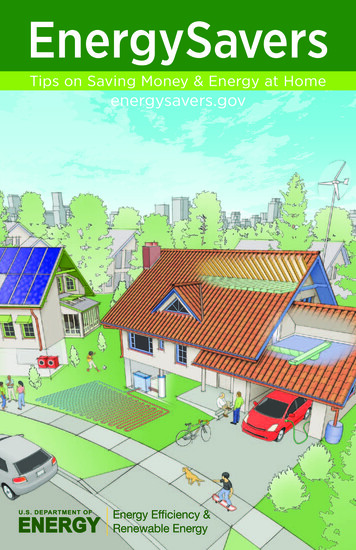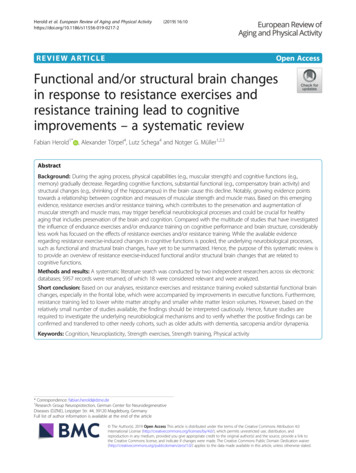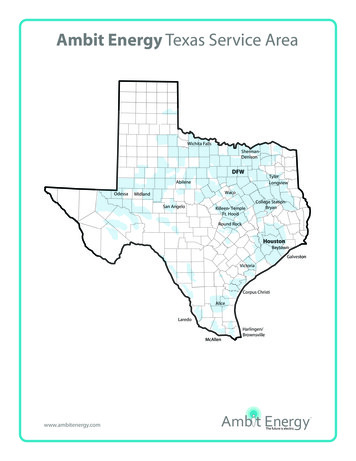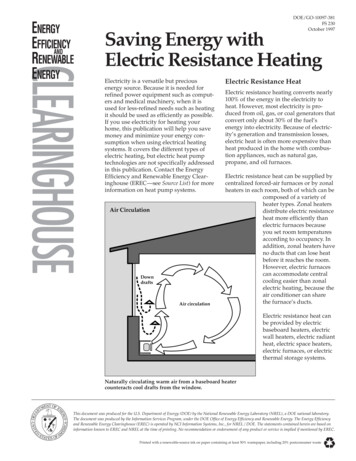
Transcription
/GO-10097-381FS 230October 1997Saving Energy withElectric Resistance HeatingElectricity is a versatile but preciousenergy source. Because it is needed forrefined power equipment such as computers and medical machinery, when it isused for less-refined needs such as heatingit should be used as efficiently as possible.If you use electricity for heating yourhome, this publication will help you savemoney and minimize your energy consumption when using electrical heatingsystems. It covers the different types ofelectric heating, but electric heat pumptechnologies are not specifically addressedin this publication. Contact the EnergyEfficiency and Renewable Energy Clearinghouse (EREC—see Source List) for moreinformation on heat pump systems.Air CirculationDowndraftsAir circulationElectric Resistance HeatElectric resistance heating converts nearly100% of the energy in the electricity toheat. However, most electricity is produced from oil, gas, or coal generators thatconvert only about 30% of the fuel’senergy into electricity. Because of electricity’s generation and transmission losses,electric heat is often more expensive thanheat produced in the home with combustion appliances, such as natural gas,propane, and oil furnaces.Electric resistance heat can be supplied bycentralized forced-air furnaces or by zonalheaters in each room, both of which can becomposed of a variety ofheater types. Zonal heatersdistribute electric resistanceheat more efficiently thanelectric furnaces becauseyou set room temperaturesaccording to occupancy. Inaddition, zonal heaters haveno ducts that can lose heatbefore it reaches the room.However, electric furnacescan accommodate centralcooling easier than zonalelectric heating, because theair conditioner can sharethe furnace’s ducts.Electric resistance heat canbe provided by electricbaseboard heaters, electricwall heaters, electric radiantheat, electric space heaters,electric furnaces, or electricthermal storage systems.NT OFMEENRTEREDThis document was produced for the U.S. Department of Energy (DOE) by the National Renewable Energy Laboratory (NREL), a DOE national laboratory.The document was produced by the Information Services Program, under the DOE Office of Energy Efficiency and Renewable Energy. The Energy Efficiencyand Renewable Energy Clearinghouse (EREC) is operated by NCI Information Systems, Inc., for NREL / DOE. The statements contained herein are based oninformation known to EREC and NREL at the time of printing. No recommendation or endorsement of any product or service is implied if mentioned by EREC.MU N ITICAGYERDEPANaturally circulating warm air from a baseboard heatercounteracts cool drafts from the window.STAAT E S OFPrinted with a renewable-source ink on paper containing at least 50% wastepaper, including 20% postconsumer waste
Electric Baseboard HeatersElectric baseboard heaters are zonalheaters controlled by thermostats locatedwithin each room. Baseboard heaters contain electric heating elements encased inmetal pipes. The pipes, surrounded byaluminum fins to aid heat transfer, run thelength of the baseboard heater’s housing,or cabinet. As air within the heater iswarmed, it rises into the room, and coolerair is drawn into the bottom of the heater.Some heat is also radiated from the pipe,fins, and housing.Electric Baseboard HeaterThermostatCabinetThe baseboard heater’s electric heating elements are surrounded by metal fins.These fins help to heat air circulating through the heater’s cabinet. Built-inthermostats are satisfactory for small rooms or seldom-used rooms, but largerrooms need remote thermostats for adequate comfortversatile but preciousenergy source thatwe need to usewisely and conservewhenever possible.Electric Wall HeatersElectric wall heaters consist of an electricelement with a reflector behind it to reflectheat into the room and usually a fan tomove air through the heater. They are usually installed on interior walls becauseinstalling them in an exterior wall makesthat wall difficult to insulate.Electric Radiant HeatFinsElectricity is acontrol. Look for labels from Underwriter’s Laboratories (UL) and theNational Electrical Manufacturer’s Association (NEMA). Compare warranties of thedifferent models you are considering.Baseboard heaters are usually installedunderneath windows. There, the heater’srising warm air counteracts falling cool airfrom the cold window glass. Baseboardheaters are seldom located on interiorwalls because standard heating practice isto supply heat at the home’s perimeterwhere the greatest heat loss occurs.Baseboard heaters should sit at least threequarters of an inch (1.9 centimeters) abovethe floor or carpet. This is to allow thecooler air on the floor to flow under andthrough the radiator fins so it can beheated. The heater should also fit tightly tothe wall to prevent the warm air from convecting behind it and streaking the wallwith dust particles.The quality of baseboard heaters variesconsiderably. Cheaper models can benoisy and often give poor temperature2Electric furnaces and baseboard heaterscirculate heat by moving air. In contrast,radiant heating systems radiate heat to theroom’s objects, including its people. Forexample, you can feel a ceiling-mountedradiant heating panel warming your headand shoulders if you stand underneath it.There are several types of electric radiantheaters. The most common are electricheating cables imbedded in floors or ceilings. Other radiant heating systems usespecial gypsum ceiling panels equippedwith factory-imbedded heating cables.Newer ceiling-mounted radiant panelsmade of metal provide radiant heat fasterthan other types because they contain lessmaterial to warm up.Radiant heat offers draft-free heating thatis easily zoned. Unlike other heating systems, it occupies no interior space. Thisallows you complete freedom to place furniture without worrying about impedingair flow from floor registers or baseboardheaters. Manufacturers claim that radiantheat can provide comfort similar to othersystems at lower indoor air temperatures,saving around 5% of space heating costs.Critics of radiant heat say that it can bedifficult to control air temperature with athermostat. The large heat-storage capacity of the concrete or plaster surroundingthe heating cables may result in greaterthan-normal fluctuations in the room airtemperature, since it takes quite a while toheat up the storage mass. Also, some
Portable electric space heaters can pose asignificant safety hazard unless they havesafety features and are used properly.Many cheaper or older portable electricspace heaters are not safe for most homeuses. Their red-hot elements and lack ofsafety features can lead to fires. Whenbuying a portable electric space heater,select one with all of these safety features:Radiant Ceiling Panel tip-over switch that automatically shutsoff the heater if it falls over, protective grille to prevent anyone fromtouching the heating elements, and sealed heating elements encased inmetal or ceramic.To use your portable electric space heatersafely, follow these guidelines.Heat radiates from the ceiling to people and objects in the room, rather thandepending on air circulation. Radiant ceiling panels give almost instant comfort,allowing residents to turn heaters on and off like lights.occupants complain about their headsbeing too warm in rooms that utilize ceiling radiant heat.Electric radiant heatoffers draft-freewarmth that is easilyzoned to heat differentparts of the house atdifferent times.Supplying heat at the ceiling or floor,which are locations that typically borderthe outdoors or unheated spaces, canresult in greater heat losses. For example,if there are any flaws in a heated concreteslab or gaps in the ceiling insulation aboveheating elements, a significant percent ofthe electric heat may escape to the outdoors without ever heating the home. Check what other appliances share thespace heater’s electric circuit to preventoverloading circuits. Avoid using extension cords. Inspect the cord on the heater for anycracks or worn spots, and replace thecord or heater if any are found. Make sure the area in which you areusing the heater has a properly functioning smoke detector. Keep combustible objects, such as blankets, furniture, drapes, toys, etc., at leastsix feet (two meters) away from theheating elements.Portable Electric HeaterElectric Space HeatersElectric space heaters come in a wide variety of models, either built-in or portable.These heaters may have fans to circulateheated air and may also be designed totransfer some of their heat by radiation. Allof these heaters must be given adequateclearance to allow air to circulate safely.Portable space heaters, as well as manybuilt-in space heaters for small rooms, havebuilt-in thermostats. Larger rooms heatedwith built-in electric space heaters shouldhave low-voltage thermostats installed inan area that maintains the room’s averagetemperature (see the section “Thermostatsfor Electric Heating” on page 7).3This radiant heater is one of several types ofelectric space heaters available. These heaterscan save you money if you set the centralthermostat lower and use these to heat individual rooms.
Electric FurnacesElectric Thermal StorageElectric furnaces can be a more expensivelong-term heating option because of theirduct heat losses. The home’s air is delivered to the furnace through return ducts,and heated air is delivered back to thehome through supply ducts. If these ductsrun through unheated areas, they losesome of their heat through air leakage aswell as heat radiation and convection fromthe duct’s surface.Some electric utilities structure their ratesin a way similar to telephone companiesand charge more for electricity during theday and less at night. They do this in anattempt to reduce their “peak” demand.Blowers (large fans) in electric furnacesmove air over a group of three to sevenelectric resistance coils, called elements,which are each rated at five kilowatts. Thefurnace’s heating elements activate instages to avoid overloading the home’selectrical system. Overheating is prevented by a built-in thermostat called alimit controller. This limit controller mayshut the furnace off if the blower fails or ifa dirty filter is blocking air flow.Electric FurnaceHeated air to houseHeatingelementsIf you are a customer of such a utility, youmay be able to benefit from a heating system that stores electric heat during nighttime hours when rates are lower. This iscalled an electric thermal storage heater,and while it does not save energy, it cansave you money because you can takeadvantage of these lower rates. However,electric thermal storage is a seldom-usedtype of electric heating.The most common type of electric thermalstorage heater is a resistance heater withelements encased in heat-storing ceramic.Central furnaces incorporating ceramicblock are also available, although they arenot as common as room heaters. Storingelectrically heated hot water in an insulated storage tank is another thermal storage option.Some storage systems attempt to use theground underneath homes for thermalstorage of heat from electric resistancecables. However, this requires painstakinginstallation of insulation underneath concrete slabs and all around the heatingelements to minimize major heat losses tothe earth. Ground storage also makes itdifficult for thermostats to control indoortemperatures.Energy-Saving MeasuresFilterCool airreturnFanIn an electric furnace, a squirrel-cage fan blows air over electric resistance coilsand into the main duct, where the warm air then enters your home.4No matter what electric heating systemyou use, there are steps you can take toreduce your energy consumption. Thesemethods include maximizing insulation,perhaps installing quality windows,reducing air leakage, using zone heating,and regularly replacing or cleaning filtersin forced-air systems, all of which willmake your home more comfortable andefficient and will save you money.
WindowsCommon Points of Air LeakageInstead of R-value, windows are usuallyrated by their heat transfer coefficient, orU-value. The lower the U-value, the betterthe window’s thermal resistance, or resistance to heat loss.ChimneysAttichatchWindowsRecessedlightsWhile energy-efficient windows areimportant in any house, electrically heatedhomes especially should have windowswith U-values of less than 0.40. Advancedwindow designs incorporate multipleglazing layers, heat-reflective coatings, orgas fillings to reach U-values less than0.25. Installing storm windows—evenover double-pane windows—is often costeffective for homes in cold climates withhigh electricity costs. (Contact EREC formore information on ing Air LeakageYour Home’s EnvelopeBasementwindowsSillplatesDuctsThe electrically heated home should be as tight as possible. Here are somecommon air leakage points that can be sealed with caulk, weatherstripping,and insulation.InsulationAn electrically heatedhome needs to be wellsealed against airinfiltration yet allowfor adequate freshair intake.To keep heating costs reasonable, electrically heated homes should be very wellinsulated. Insulation’s ability to slow heatflow is measured by R-value (“R” standsfor thermal “resistance”). The higher theR-value, the better the insulation restrictsheat flow.However, just because you have an adequate R-value does not necessarily meanyour home is well-insulated. The insulation must be properly installed as well.Gaps and voids in the insulation—evensmall ones—create air convection orair leakage that markedly reduce ratedR-values. For more information on insulation, contact EREC.5To reduce your heating costs, your home’sexterior walls—also known as the “envelope”—need to be as airtight as possibleyet still provide healthy indoor air. Methods to achieve an airtight home are nowpracticed by many building contractors.Air-sealing measures include wrappingthe shell of the new house with an airinfiltration barrier and installing gasketsand sealants to thoroughly seal joints andpenetrations in the building shell. However, these steps are not foolproof. Complicated floor plans, irregular roof lines,protruding windows, cathedral ceilings,fireplaces, or recessed light fixtures canmake air sealing during construction difficult, if not impossible. As a result, homeswith some or all of these features oftenhave high heating costs due to excessiveair leakage.Your Home’s Duct WorkA forced-air furnace’s air ducts also influence residential air leakage. Homes withfurnaces and ducts sometimes havegreater air leakage than homes withoutducts, such as radiant-heated or baseboard-heated homes. Heat is frequently
Zone heating canproduce energysavings of more than20% compared toheating every room—occupied andunoccupied—in yourhouse.lost through leaky or uninsulated ducts.Joints between sections of ducts, betweenducts and registers, and between ductsand the furnace can lose as much as 30%of the air being moved by the blower.Leaking ductwork can create positive andnegative room pressures that oftenincrease air leakage through floors, exterior walls, and ceilings. Reducing or eliminating air leaks will make your homemore energy efficient and comfortable.The importance of airtight ducts has onlyrecently been recognized by the buildingindustry. New ducts need to be sealedwith commercial duct mastic as they areassembled. Existing duct systems can beleak-tested and sealed by an experiencedprofessional. Contact EREC for moreinformation on this.One recommended zone heating strategyinvolves controlling the centralized heating system with an automatic setbackthermostat. During the times when everyone is at home and active, the automaticsetback thermostat provides a comfortabletemperature throughout the house. For theremainder of the day or night, it lowershouse temperatures to between 50 F and60 F (between 10 C and 15.6 C). Duringthese setback times, zone heaters provideadditional room heat only as needed.Zone HeatingFurnace FiltersZone heating cuts costs by heating therooms occupied by you or your familywhile allowing unoccupied sections toremain cooler.Furnace filters are designed to keep theblower, heat exchanger, and ductworkclean. Your furnace cannot run as efficiently if the filters, blowers, and heatingcoils are dirty. Plus, it is much easier tochange or clean filters than to clean blowers, heating coils, and ductwork.Electric Zone HeatingFilters are composed of either fiberglasswool framed in cardboard, air-permeablefoam rubber, or fibrous plastic. They areusually positioned near the blower.Depending on the type of filter used inyour system, it is a good idea to replace orclean them monthly during the heatingseason. Read your furnace’s instructionmanual for more information.68 55 Zone heating can produce energysavings of more than 20% compared toheating both occupied and unoccupiedareas of your house. Of course, theamount of savings you will achievedepends on how the portable or built-inzone heaters are combined with your centralized heating system.55 68 Indoor Air Quality andVentilation68 Zone heating is energy efficient because it heats only those areas of yourhouse in which there are people.6Many homes that use zonal electric heating systems (baseboard or radiant heat)have very low air leakage rates. Chimneysand leaky ducts promote air leakage,because they can create pressure differentials within the home. This unintentionalventilation keeps the air indoors moving.However, uncontrolled air leakage is apoor way to keep air fresh in any home—and especially in an electrically heated
home. A controlled mechanical heat recovery ventilation (HRV) system is the preferred way to provide good indoor airquality. Contact EREC (see Source List) formore information on HRV systems.Zone-heated homes with fairly airtightbuilding shells can have moisture and airpollution problems because of very lowair leakage along with the lack of a ventilation system. Mechanical ventilation canremove air pollution and moisture. A relatively airtight, electrically heated homeshould be supplied with fresh air from acontrolled mechanical ventilation system.This ventilation system can consist ofexhaust fans, a central exhaust air system,an air-to-air heat exchanger with its ownducts, or an outdoor-air inlet into an electric furnace or heat pump.Thermostats for Electric HeatingChoosing the right thermostat for yourelectric heating system is crucial to maintaining a comfortable indoor environmentand enhancing your home’s energy efficiency. Thermostats are classified as linevoltage or low-voltage thermostats,depending on whether the heater’s electric current flows through them. Thermostats are called built-in if they areattached to the heater and remote if theyare mounted on a wall.Line-Voltage ThermostatsThe most simple thermostat is the linevoltage thermostat, which is used forbaseboard and radiant electric heat. Theelectricity it controls flows through it—much like a light switch. Line-voltagethermostats can be either built-in orremote. Built-in, line-voltage thermostatsare attached directly to the heater and aresubjected to temperature extremes. Therefore, they often do not sense room temperatures accurately. While portable electricheaters must have built-in thermostats,baseboard or radiant heaters provide better room comfort when controlled byremote thermostats. Line-voltage thermostats, installed on interior walls, aremore accurate because they measure thetemperature of the air of the occupiedspace rather than the temperature at theheater itself.7Low-Voltage ThermostatsLow-voltage thermostats are used onelectric furnaces, heat pumps, and onbaseboard and radiant heaters in largerooms for better temperature control.Low-voltage thermostats require a transformer to reduce voltage and a relay(remote-controlled switch) to turn theheater on and off.Low-voltage thermostats are alwaysinstalled in remote locations, rather thanbeing integrated into the heater. Theycontrol temperature more precisely thanline-voltage thermostats. Low-voltagethermostats are preferred for larger rooms,heated by radiant panels or electric baseboard heaters, because they producebetter comfort.Automatic Setback ThermostatsAutomatic setback thermostats combine aclock and a thermostat to control theheater automatically. They are convenientand very effective at saving energy. If yourfamily has a regular schedule of being athome and away, a setback thermostatcould save you 5% to 20% of your heatingand cooling costs depending on the duration of setback periods and the degrees oftemperature setback.Automatic setback thermostats can beused to control all types of electric heat.For baseboard and radiant heat, line voltage setback thermostats are available.These are either programmed with a clockor they require the user to push a buttonat regular intervals to avoid the setbacktemperature (usually 10 or 15 degrees).Contact EREC (see Source List) for moreinformation on automatic and programmable thermostats.Further InformationMany utilities offer grants, loans, orrebates to encourage energy efficiency.Contact your local electric utility forinformation about residential energy conservation, insulation and weatherizationprograms, electric thermal storage, orheat pumps.
Source ListFor more information about these, and other, energy efficiencytopics, contact:Edison Electric Institute (EEI)701 Pennsylvania Avenue NWWashington, DC 20004–2696(202) 508–5424www.eei.orgThe Energy Efficiency and Renewable EnergyClearinghouse (EREC)P.O. Box 3048Merrifield, VA 22116(800) DOE–EREC (363–3732)Fax: (703) 893–0400E-mail: doe.erec@nciinc.comEEI is the association of the nation’s investor-owned electricutility companies and provides information on a variety ofelectricity topics through its publications catalog.Electric Power Research Institute (EPRI)3412 Hillview AvenuePalo Alto, CA 94304(650) 855-2000www.epri.comEREC provides free general technical information to the publicon the many topics and technologies pertaining to energy efficiency and renewable energy.There are many groups that can help you make aninformed decision when purchasing an energy efficiencyproduct or system. The following trade associations alsooffer educational services relating to electric heating,conservation of electricity, and energy efficiency.EPRI, a research consortia, develops solutions to make thegeneration, delivery, and use of electricity affordable, efficient,and environmentally sound.American Public Power Association (APPA)2301 M Street NWWashington, DC 20037–1484(202) 467–2900Fax: (202) 467-2910Reading ListHome Energy Magazine2124 Kittredge Street, #95Berkeley, CA 94704(510) 524–5405APPA is a public utility membership organization that conducts research programs, compiles statistics, and offers education courses for electric utilities and cooperatives.This publication provides information on reducing energyconsumption.Building Research CouncilUniversity of Illinois at Urbana–Champaign1 East St. Mary’s RoadChampaign, IL 61820(217) 333-1801Fax: (217) 244-2204www.arch.uiuc.edu/research/brcThis organization publishes a variety of fact sheets about homeheating and energy conservation.8
Electric space heaters come in a wide vari-ety of models, either built-in or portable. These heaters may have fans to circulate heated air and may also be designed to transfer some of their heat by radiation. All of these heaters must be given adequate clearance to allow air to circulate safely. Portable space heaters, as well as many
